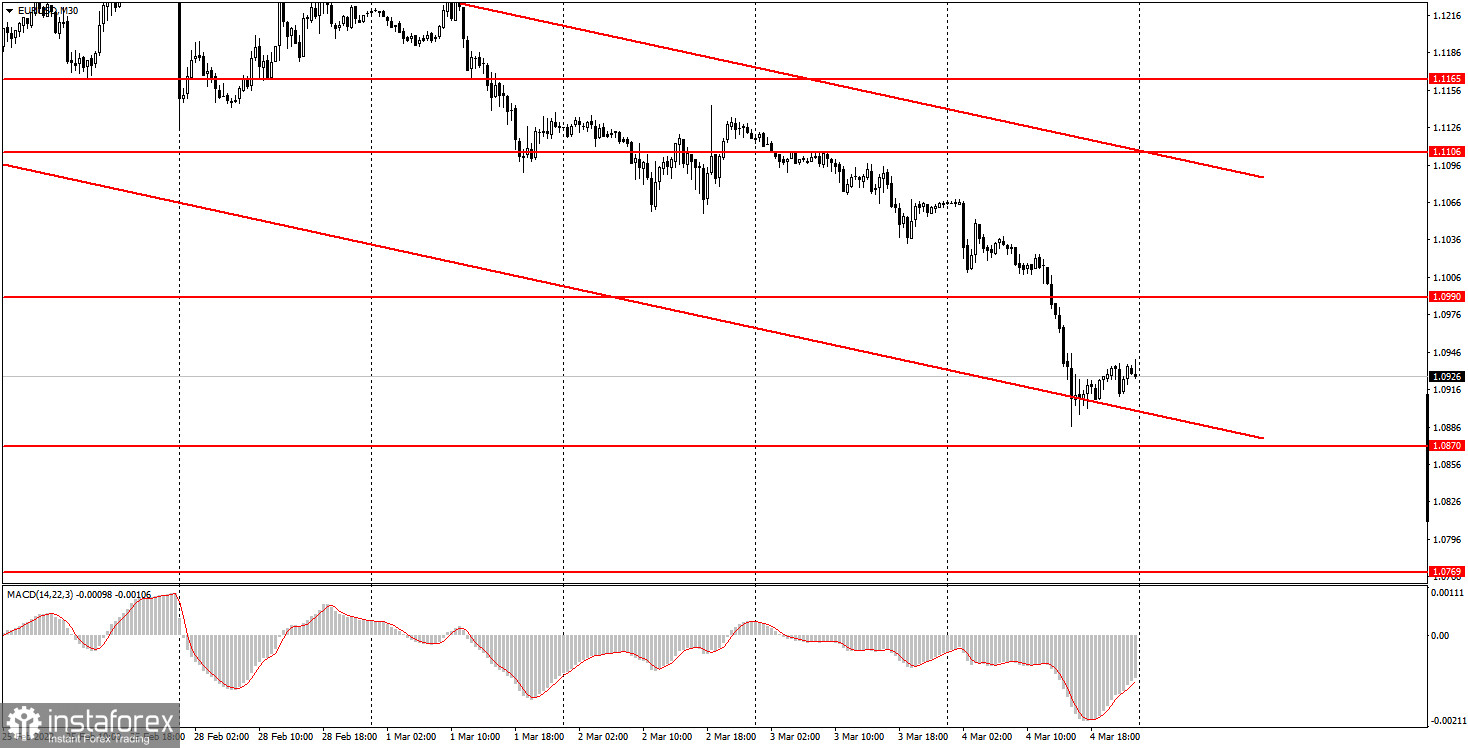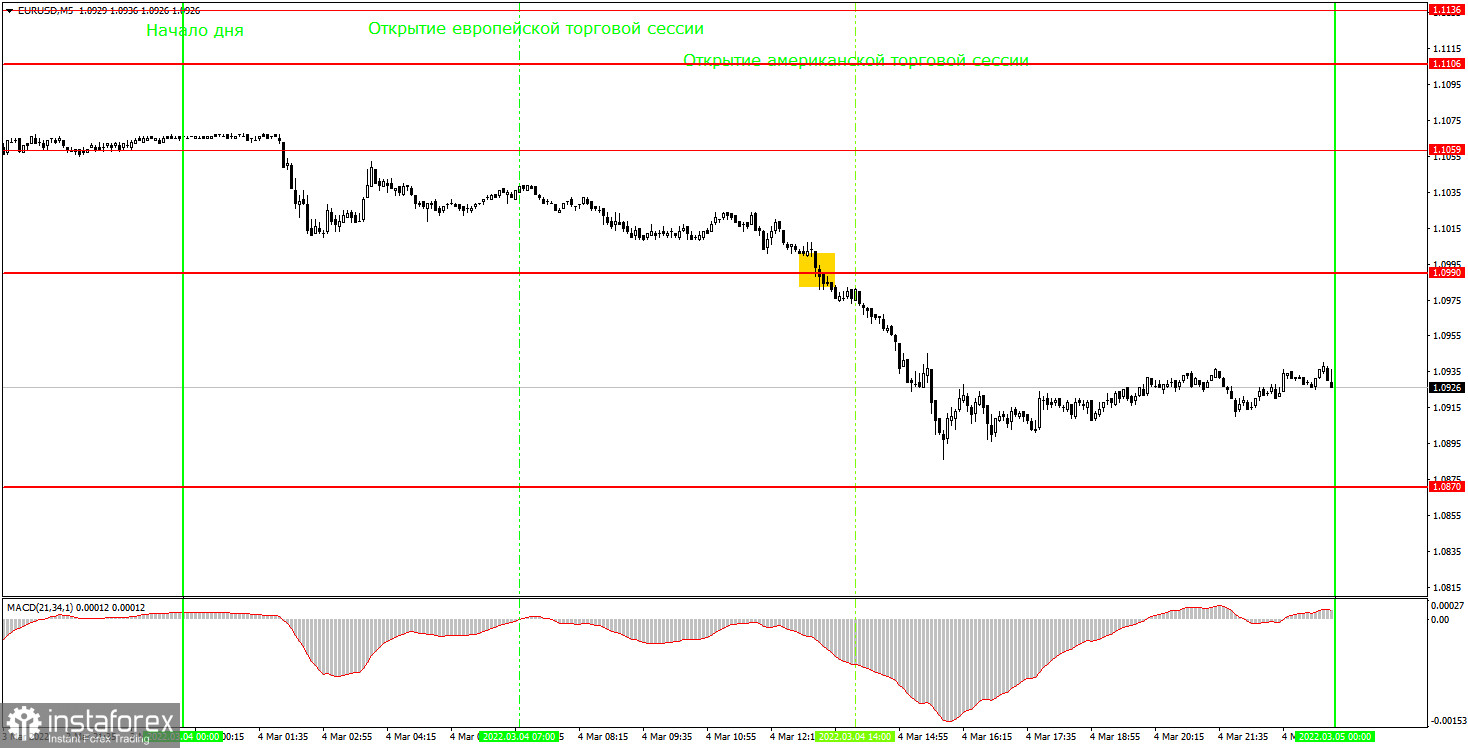Analyzing trades on Friday:
EUR/USD on 30M chart

On Friday, trading activity on EUR/USD was rather high, and the pair was moving mostly in one direction throughout the day. The downtrend continues, which is confirmed by the descending channel. The pair is declining almost every day, so now we are dealing with a very strong downward movement. The current geopolitical situation is to blame for this fall. Someone might think that on Friday the US dollar advanced thanks to strong macroeconomic data. However, this is not entirely true. First of all, the price began to decline at night when there was no news. Secondly, it resumed its fall three hours before the release of the data in the US. Thus, the European currency had been depreciating even before the unemployment data and nonfarm payrolls reports were published in the US. Yet, the unemployment rate that fell to 3.8% and more than 600,000 new jobs outside the agricultural sector (far more than expected) also fueled the demand for the US dollar. So, on Friday, the greenback benefited both from the geopolitical situation and the macroeconomic background.
EUR/USD on 5M chart

On the 5-minute time frame on Friday, the pair was declining for the whole day. Only by the end of the session, the pair started a slight upside pullback which was of no use. There was only one trading signal formed during the day as this price area has very few levels to trade from. The fact is that the price has not been so low for a very long time. When the pair broke through the level of 1.0990, traders had a good opportunity to sell. The quote failed to go down to the nearest target level of 1.0870. Therefore, the trade had to be closed manually in the late afternoon, which could have brought us about 70 pips. Traders could have downplayed the macroeconomic data from the US. By the time of the news release, the price had already declined by more than 15 pips. So, when opening this trade, beginners should have set a Stop Loss to breakeven. Friday turned out to be an excellent day for trading: there were few trading signals, and all trades turned out to be profitable.
Trading tips on Monday
On the 30-minute time frame, the downtrend is still in place. Therefore, it is better to stay bearish on the pair. If the price manages to consolidate above the channel, then it would be possible to say that the downtrend is over. At the moment, the geopolitical factor is strongly affecting traders' sentiment, so it is likely that the US dollar will surge again in case the situation worsens. However, this process cannot continue forever. On the 5-minute time frame on Monday, it is recommended to trade at the levels of 1.0769, 1.0870, 1.0990, 1.1059, and 1.1106. You should set a Stop Loss to breakeven as soon as the price moves by 15 pips in the right direction. On Monday, there will be no important reports either in the US or in the EU. Thus, when making trading decisions, you will have to rely only on the geopolitical factor and technical analysis. If the news background is relatively stable, the pair may start a slight upward correction. Otherwise, the decline may continue.
Basic rules of the trading system
1) The strength of the signal is determined by the time it took the signal to form (a rebound or a breakout of the level). The quicker it is formed, the stronger the signal is.
2) If two or more positions were opened near a certain level based on a false signal (which did not trigger a Take Profit or test the nearest target level), then all subsequent signals at this level should be ignored.
3) When trading flat, a pair can form multiple false signals or not form them at all. In any case, it is better to stop trading at the first sign of a flat movement.
4) Trades should be opened in the period between the start of the European session and the middle of the US trading hours, when all positions must be closed manually.
5) You can trade using signals from the MACD indicator on the 30-minute time frame only amid strong volatility and a clear trend that should be confirmed by a trendline or a trend channel.
6) If two levels are located too close to each other (from 5 to 15 pips), they should be considered support and resistance levels.
On the chart
Support and Resistance Levels are the levels that serve as targets when buying or selling the pair. You can place Take Profit near these levels.
Red lines are channels or trend lines that display the current trend and show in which direction it is better to trade now.
The MACD indicator (14, 22, and 3) consists of a histogram and a signal line. When they cross, this is a signal to enter the market. It is recommended to use this indicator in combination with trend patterns (channels and trendlines).
Important announcements and economic reports that can be found on the economic calendar can seriously influence the trajectory of a currency pair. Therefore, at the time of their release, we recommend trading as carefully as possible or exiting the market in order to avoid sharp price fluctuations.
Beginners on Forex should remember that not every single trade has to be profitable. The development of a clear strategy and money management is the key to success in trading over a long period of time.





















